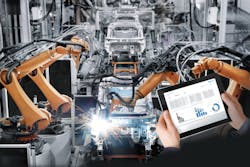Before the introduction of smart components to industry, manufacturing and processing operations lived in a break/fix mechanical world where maintenance personnel could practically look at a machine and know what was causing it to stop. In those days, long runs of the same product led to fewer changeovers with less tinkering and adjusting.
Today, changeovers occur frequently, and machines are complex and difficult to analyze. Fewer personnel possess exceptional diagnostic insights. With today’s high costs and liability issues, downtime and poor quality need to approach zero incidents.
As advanced as they seem, machine learning and AI are not bleeding edge solutions, but practical tools available now. Festo has found that machine learning/AI can improve process transparency by 100%, lower waste by more than 50%, and decrease product rejection costs by more than 45%. Machine availability can be improved by more than 25%. Unplanned downtime can fall by more than 20%.
Identification of anomalies, now what?
Early in the machine learning/AI development process, it became clear that end users wanted the AI healthy/not healthy data available in the way most convenient for them, whether on their own dashboards, resident on premises, on edge devices, or all three. Some customers wanted the data integrated with their maintenance management systems. Others wanted alerts sent to mobile devices. Many end users asked whether they could have easily understood messages identifying what the problem was, where it was and what corrective action should be taken. Some of these end users wanted information delivered via text message.
Given these varied requirements, a machine learning/AI system must be flexible enough to enable connections to internal maintenance management software or spare parts management system to create an integrated end-to-end solution. The point for the end user is to ensure the machine learning/AI vendor provides a system customizable to the needs of the operation.
Frank Latino is product manager, electric automation, Festo North America.
About the Author
Frank Latino, Festo
Product Manager, Festo

Leaders relevant to this article:


